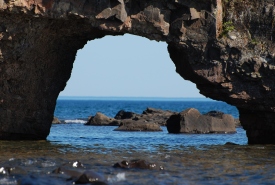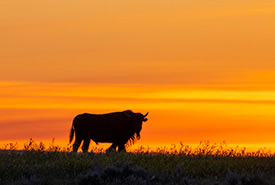The Best-Kept Secrets in Canada
Just above Maine lies a world-class nature destination. It’s a wild, rugged landscape with granite plateaus gashed by rushing rivers and waterfalls that plummet from sheer rock walls into shadowy gorges. Here, bears roam the woodlands and whales ply fjords…and 27 national parks beckon exploration.
While you’ve surely heard of Canada’s first, most famous and most visited national park—Banff, in the heart of Alberta’s Rockies—you may be less familiar with the wild gems of Quebec. Yet some of the best national parks in Canada are found in this largest of the country’s provinces, occupying one-sixth of Canada’s land mass.
Half of Quebec is covered in forest, 4,500 rivers lace its terrain, and more than a million lakes dot the province, which holds 3% of the world’s renewable fresh water. And the world’s largest estuary, the Gulf of St. Lawrence, is home to a profusion of marine life including a dozen whale species.
Nature’s power and glory are on full display in Quebec, showcased in a collection of parks on par with North America’s most celebrated landscapes. In addition to three Parks Canada sites, Quebec is home to 24 national parks administered by the provincial government, to protect places of exceptional character and national significance. Many are readily accessible from the U.S., including these five that offer a diverse cross-section of Quebec’s stunning natural features.

Jacques-Cartier National Park
Named for the French navigator and first European to explore the St. Lawrence River in the 16th century, this 230-square-mile wilderness park lies just 30 minutes north of Quebec City. On this vast plateau cut by deep glacial valleys, the crystal-clear Jacques Cartier River flows between 1,800-foot mountains. Wildlife abounds, including moose, bear, white-tailed deer, foxes, wolves, porcupine and 130 different bird species. Outdoor aficionados are drawn to a multitude of recreation opportunities including hiking, canoeing, whitewater kayaking, rafting, sailing on Lac Beauport, and fishing for brook trout, Arctic char and Atlantic salmon. Fall is a spectacular season, when deciduous woodlands in the valleys catch fire with color, contrasting against the coniferous forests atop the high plateau.

Hautes-Gorges-de-la-Rivière-Malbaie National Park
Established as a national park in 2000, this area is one of the core zones of UNESCO’s Charlevoix Biosphere Reserve, a diverse matrix of ecosystems with World Heritage status. In the hinterlands above the St. Lawrence River, this park is named for a network of deep gorges cut into a range of high mountains. Its vertical rock faces are the highest east of the Rockies. The park is famed for its hiking trails, and the most notable among them takes sturdy hikers to the top of 3,248-foot Montagne des Érables (Maple Mountain), with views from the highest cliffs in Eastern Canada. Far below, enjoy canoeing, kayaking, riverboat cruises on the Malbaie River, the famous waterway used to transport logs downstream until 1985. Fish abound in the river, attracting several species of fishing birds including osprey and great blue heron. Look, too, for beaver and moose along the river lowlands.

Grands-Jardins National Park
Named for its intriguing carpets of ground lichen, ancient boreal forest (taiga), and arctic vegetation rare at this latitude, the variegated green wonderland of “Grand Gardens” entices hikers, anglers and wildlife lovers to its sprawling heights and valleys. In this key component of the UNESCO-listed Charlevoix Biosphere Reserve, we find a diverse array of wildlife including spruce grouse, black bear, gray wolf, lynx, woodland caribou and red fox. Listen for the evocative call of the loon on the park’s 60 lakes, which along with its rivers and streams are renowned for their native fish habitat, with brook trout the coveted prize. Hikers will want to explore the 33-mile-wide impact crater formed by a massive meteorite 360 million years ago, while the trail to the summit of Mont du Lac-des-Cygnes offers a 360-degree view of the crater remains and Laurentian massif.
Saguenay Fjord National Park
The centerpiece of this park located along the eastern end of the Saguenay River is its namesake, the 65-mile fjord that is the longest in the world at this low latitude. Its formation reveals a fascinating geological story: the result of a glacial collapse thousands of years ago that left an inlet walled by 980-foot-high cliffs. The fjord is also interesting in that it empties into an estuary—the Gulf of St. Lawrence—rather than the ocean. The waters of Saguenay Fjord support a host of marine life, with four whale species: blue, fin, minke and beluga. The park is one of the best spots on the planet to see belugas, which congregate in Baie-Sainte-Marguerite in the summer—don’t miss the Beluga Interpretation Center here to learn more. On shore and in the rocky, forested heights above the fjord, other wildlife thrives, although it is less frequently seen. Lucky visitors might spy a moose or beaver, or more rarely, a glimpse of black bear, wolf or lynx.

Saguenay-St. Lawrence Marine Park
The only park in Québec to preserve and enhance an exclusively marine environment, Saguenay-St. Lawrence is world-renowned for whale watching. Its location at the confluence of the St. Lawrence and Saguenay rivers as they drain into the sea provides ideal habitat for marine mammals and other sealife. In this estuarine environment, the dynamic mixing of freshwater and saltwater creates a rich food supply for the eight whale species found here. Responsible excursions with Eco-Whale Alliance operators offer encounters with beluga, sperm, minke, fin, blue, humpback, gray, Northern Atlantic right, northern bottlenose, and rare bowhead whales, all or some of which may be on view in season, though belugas live here year-round. While several cetacean species are endangered, some, such as the Northern Atlantic right whale, are appearing in greater numbers in recent years. Greenland sharks, harbor porpoises and several seal species are also found in these waters.
Discover this sampler of Quebec’s national parks when you join Nat Hab to explore the Whales & Nature Trails of Quebec.
About the author: Wendy Redal View all posts by Wendy Redal
Wendy’s passions are travel, nature, conservation and communication, which intersect in her position as Nat Hab’s Editorial Director. Incorrigibly peripatetic, Wendy has been to more than 65 countries and all 50 states. Among her most magical wildlife encounters are snorkeling with sea lions in the Galapagos, sitting face to face with a silverback gorilla in the mountains of Africa, and watching a huge brown bear calmly amble by just feet away in the wilderness of Alaska’s Katmai National Park.




